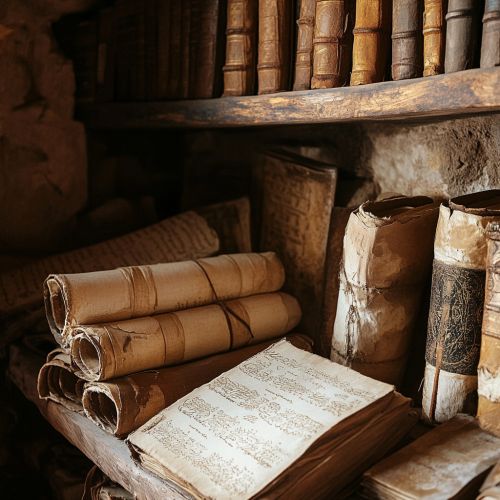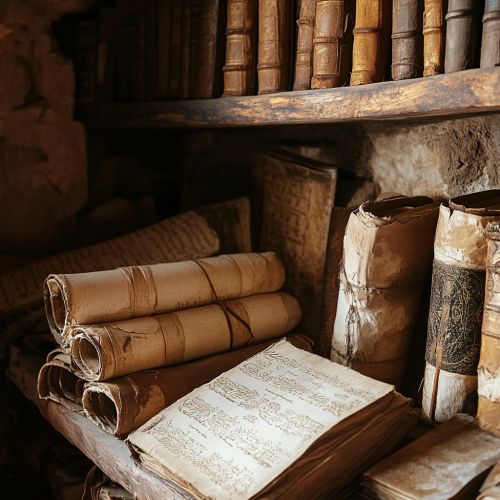Literary history: Difference between revisions
(Created page with "== Introduction == Literary history is the study of literature and its development over time. This field encompasses the evolution of literary forms, genres, and styles, as well as the socio-cultural contexts in which literature is produced and consumed. Literary history also examines the influence of historical events, philosophical movements, and technological advancements on literature. == Ancient Literature == === Mesopotamian and Egyptian Literature === The earlies...") |
No edit summary |
||
| Line 65: | Line 65: | ||
* [[Contemporary literature]] | * [[Contemporary literature]] | ||
[[Image:Detail-97637.jpg|thumb|center|Ancient library with scrolls and manuscripts.|class=only_on_mobile]] | |||
[[Image:Detail-97638.jpg|thumb|center|Ancient library with scrolls and manuscripts.|class=only_on_desktop]] | |||
== Categories == | == Categories == | ||
Latest revision as of 21:30, 18 August 2024
Introduction
Literary history is the study of literature and its development over time. This field encompasses the evolution of literary forms, genres, and styles, as well as the socio-cultural contexts in which literature is produced and consumed. Literary history also examines the influence of historical events, philosophical movements, and technological advancements on literature.
Ancient Literature
Mesopotamian and Egyptian Literature
The earliest known literary texts originate from ancient Mesopotamia and Egypt. The Epic of Gilgamesh, dating back to around 2100 BCE, is one of the oldest known works of literature. This epic poem, written in Akkadian, explores themes of heroism, friendship, and the quest for immortality. Similarly, ancient Egyptian literature, such as the Pyramid Texts and the Book of the Dead, provides insights into the religious beliefs and practices of the time.
Greek and Roman Literature
Ancient Greek literature, beginning around the 8th century BCE, laid the foundation for Western literary traditions. Homer's epics, the Iliad and the Odyssey, are seminal works that have influenced countless subsequent literary creations. Greek tragedy, as exemplified by the works of Aeschylus, Sophocles, and Euripides, and Greek comedy, represented by Aristophanes, also played crucial roles in the development of drama.
Roman literature, heavily influenced by Greek precedents, produced significant works in both poetry and prose. Virgil's Aeneid, an epic poem that glorifies Rome's origins, and Ovid's Metamorphoses, a mythological narrative, are key examples. Roman prose, including the philosophical writings of Seneca and the historical accounts of Tacitus, further enriched the literary landscape.
Medieval Literature
Early Medieval Period
The early medieval period, often referred to as the Dark Ages, saw the continuation of Latin literature alongside the emergence of vernacular languages. Beowulf, an Old English epic poem, is a notable example of early medieval literature. This period also witnessed the production of religious texts, such as Saint Augustine's Confessions and The City of God.
High and Late Medieval Period
The high and late medieval periods were marked by the flourishing of chivalric romance and courtly love poetry. Dante Alighieri's Divine Comedy, a monumental work of Italian literature, blends classical and Christian themes to depict the soul's journey towards God. Geoffrey Chaucer's The Canterbury Tales, written in Middle English, provides a vivid portrayal of medieval society through a series of interconnected stories.
Renaissance Literature
The Renaissance, spanning the 14th to the 17th centuries, was a period of renewed interest in classical antiquity and humanism. This era saw the rise of notable literary figures such as William Shakespeare, whose plays and sonnets remain central to the English literary canon. Miguel de Cervantes' Don Quixote, often considered the first modern novel, satirizes the chivalric traditions of the time.
Renaissance literature also includes the works of Petrarch, whose sonnets popularized the Italian sonnet form, and Erasmus, whose In Praise of Folly critiques contemporary society and the Church. The invention of the printing press by Johannes Gutenberg in the mid-15th century revolutionized the dissemination of literature, making texts more accessible to a wider audience.
Enlightenment and Neoclassical Literature
The Enlightenment, an intellectual movement of the 17th and 18th centuries, emphasized reason, science, and progress. Enlightenment literature often sought to challenge traditional authority and promote individual rights. Voltaire's Candide, a satirical novella, critiques the optimism of the time, while Jonathan Swift's Gulliver's Travels uses fantastical voyages to examine human nature and society.
Neoclassical literature, influenced by the principles of order, clarity, and decorum, drew inspiration from classical antiquity. Alexander Pope's The Rape of the Lock and Samuel Johnson's The Lives of the Poets are key examples of neoclassical works that reflect the values and aesthetics of the period.
Romanticism
Romanticism, emerging in the late 18th century, emphasized emotion, imagination, and the sublime. This literary movement was a reaction against the rationalism of the Enlightenment and the industrialization of society. William Wordsworth and Samuel Taylor Coleridge's Lyrical Ballads is often credited with initiating the Romantic movement in English literature. The works of Lord Byron, Percy Bysshe Shelley, and John Keats further exemplify Romantic poetry's focus on nature, individualism, and the supernatural.
In prose, Mary Shelley's Frankenstein explores themes of creation and monstrosity, while Jane Austen's novels, such as Pride and Prejudice, provide keen social commentary through the lens of romantic fiction.
Victorian Literature
The Victorian era, spanning the 19th century, was characterized by a diverse range of literary forms and themes. The novel became the dominant literary form, with authors such as Charles Dickens, George Eliot, and Thomas Hardy exploring social issues, morality, and human psychology. Charlotte Brontë's Jane Eyre and Emily Brontë's Wuthering Heights are notable examples of Victorian novels that delve into complex emotional and social landscapes.
Victorian poetry, represented by figures such as Alfred Lord Tennyson and Robert Browning, often grappled with themes of faith, doubt, and the human condition. The period also saw the rise of the Gothic novel, with works like Bram Stoker's Dracula and Mary Shelley's Frankenstein (though published earlier, it gained prominence in this era) contributing to the genre's enduring popularity.
Modernism
Modernism, a literary movement of the early 20th century, sought to break away from traditional forms and conventions. Influenced by rapid technological advancements and the trauma of World War I, modernist literature often features fragmented narratives, stream-of-consciousness techniques, and a focus on the inner workings of the mind. James Joyce's Ulysses, Virginia Woolf's Mrs Dalloway, and T.S. Eliot's The Waste Land are seminal modernist works that exemplify these characteristics.
Modernist literature also includes the works of Franz Kafka, whose surreal and existential narratives, such as The Metamorphosis, challenge conventional storytelling. The Harlem Renaissance, a cultural movement in the United States, produced significant modernist literature by African American writers like Langston Hughes and Zora Neale Hurston.
Postmodernism
Postmodernism, emerging in the mid-20th century, is characterized by its skepticism towards grand narratives and its embrace of irony, pastiche, and intertextuality. Postmodern literature often blurs the boundaries between fiction and reality, as seen in the works of Jorge Luis Borges, Thomas Pynchon, and Kurt Vonnegut. Don DeLillo's White Noise and Salman Rushdie's Midnight's Children are notable examples of postmodern novels that explore themes of identity, history, and culture.
Postmodernism also saw the rise of magical realism, a genre that incorporates fantastical elements into otherwise realistic narratives. Gabriel García Márquez's One Hundred Years of Solitude and Isabel Allende's The House of the Spirits are key works in this genre that reflect the blending of the magical and the mundane.
Contemporary Literature
Contemporary literature, encompassing the late 20th and early 21st centuries, is marked by its diversity of voices, forms, and themes. This period has seen the rise of global literature, with authors from various cultural backgrounds contributing to the literary landscape. Chimamanda Ngozi Adichie's Half of a Yellow Sun, Haruki Murakami's Kafka on the Shore, and Elena Ferrante's Neapolitan Novels are examples of contemporary works that reflect the global nature of modern literature.
Contemporary literature also grapples with issues such as postcolonialism, feminism, and environmentalism. Margaret Atwood's The Handmaid's Tale and Arundhati Roy's The God of Small Things are notable works that address these themes. The digital age has also influenced contemporary literature, with the rise of electronic literature and hypertext fiction challenging traditional notions of authorship and narrative.
See Also
- Epic of Gilgamesh
- Homer
- Dante Alighieri
- William Shakespeare
- Miguel de Cervantes
- Voltaire
- Romanticism
- Modernism
- Postmodernism
- Contemporary literature


